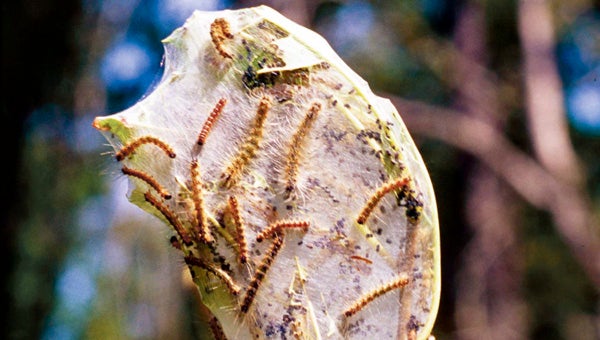
By Nelson D. Wynn
The fall webworm is usually seen from late summer through early fall.
The webworms feed on deciduous trees like hickory, walnut, birch, cherry and crabapple. The fall webworm constructs its nest or web over the leaves at the end of a branch.
The worm lives inside the web-eating leaves, and the dark spots in the bottom of the web or nest are fecal droppings.
Webworm larvae are pale yellow with two rows of black marks along their sides. The adults are covered with whitish hairs that originate from black and orange warts.
Larvae vary in color and markings, but are usually greenish with a broad, dusky stripe along the back with a yellow stripe along the side. The pupal stage is brown. Adult coloration varies considerably from pure white to white with black spots with wings.
The Fall Webworm overwinters as a pupa in a cocoon in ground litter, cracks and crevices, or in the soil.
The adults are first seen in June and continue to emerge in small numbers during most of the summer.
The females deposit egg masses on the undersurface of leaves.
The larvae hatch in seven days. They immediately begin to spin a web over the foliage they are eating.
The nest grows with the worms. The remains of these nests may persist through winter.
These webs may sometimes surround 2–3 feet of infested branch.
The larvae feed together until the last molt and then may feed independently. The larvae mature in about six weeks.
Mature larvae leave the web and pupate on or in the soil. There may be one or two generations each year.
The larval stage of this pest skeletonizes and consumes leaves inside the protection of a tent-like web they enlarge as they require additional food and grow.
They may defoliate a tree occasionally but rarely kill it. On shade trees, webs usually occur on occasional branches. They may not injure the tree appreciably, but they reduce its ornamental value.
CONTROL
•Non-chemical
Various species of natural enemies help to manage webworms.
Birds and many insect predators and parasitoids attack the larval stage. Eggs may also be destroyed by predators and insect parasitoids.
It is possible to reduce this pest’s population by mechanical control. When the webbed branches are within reach, they can be pruned and destroyed.
This may be practical if the webs have not become too large and the aesthetic shape of the woody ornamental plant is not reduced by pruning.
•Chemical
Apply a registered insecticide when webs and larvae are small. This usually occurs sometime during July.
The entire infested plant does not need to be treated. Only the webs and their associated foliage should be thoroughly covered.
For more information contact the Chilton County Extension office at (205) 280-6268 or the Master Gardener toll-free helpline at 1-877-GROW (4769), Region menu option No. 3.
This article includes research-based information from Land Grant Universities around the Country, including Alabama A&M University, Auburn University, and Penn State University.
Nelson D. Wynn is a Regional Extension Agent with the Alabama Cooperative Extension System.
